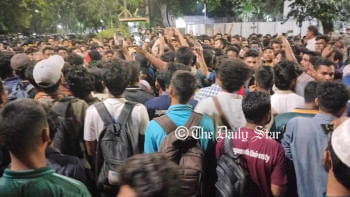Traffic problem

Photo: STAR
Dhaka is a city that has grown without any master plan. The result is unbearable traffic congestion, transformation of residential areas into commercial ones and so forth. Many have expressed their concern that Dhaka is destined to be the world's largest slum.
I would like to concentrate only on the traffic situation of the city.
Dhaka city is surrounded on three sides by rivers. This unique situation has forced the city to grow longitudinally northward from the river Buriganga. All major roads run south to north, with extremely negligible number of interconnections between these south-north main arteries. This is a major cause of traffic congestions and it is not easy to solve this problem without demolishing large tracts of built up area to make requisite numbers of east-west interconnections.
More importantly, the proportion of road surface area to built up area amounts to a paltry 7% approximately as against 25% recommended for a good city planning. Let us not ignore the fact that this 25% is recommended taking into account a well established network of public transportation system, which is virtually in a pathetic state in Dhaka.
There have been many seminars, discussions and talk shows on the subject. Unfortunately, nothing has changed for the better. Even the much touted internationally funded urban transportation improvement project that was completed a few years ago is already outdated. We are now spending more time on the road due to gridlocks every day. We are not only wasting valuable work hours, we are also burning up costly imported fuel just waiting at the same spot for an indefinite period every day. Or should I say every hour? No one has so far calculated the financial loss due to this, but it could be assumed to be astronomical.
There are talks occasionally of building elevated motorways, elevated monorails and subways (underground train). I have a feeling from the frequency of media appearance that elevated motorway and/or elevated monorails get the greater preference amongst the three options. This to me seems that we might be going for another blunder if we go for the elevated options. In my view, we must go for subways (underground trains). This system will be more expensive than the elevated options, but will be more effective in terms of solving our problem.
The reason I am in favour of a subway is the inherent character of the city and its road system. It has already been described that our long city has a number of south to north roads with scant interconnections in-between. These interconnections are extremely important. Without those commuters have to use the roads more than they would need to if adequate interconnections were there. I guess an example would explain my contention more realistically. Suppose I want to go from Farm Gate to BG Press in Tejgaon. Currently I would have to go up to Jahangir Gate, then to Mohakhali and then back southward to BG Press. If there were a road connection in-between, I would not traverse such a roundabout way. This will not only save my time and fuel, I will spare the road not needed for my journey for others.
This is primarily the reason I feel elevated road or rails would be futile. All levitated roads or railways have to be constructed over existing roads or over empty space that would not be or cannot be used for future construction. Since we do not have such empty space, our only option would be to build those over existing roads. This will again leave us with a number of long south to north long roads with negligible interconnections. We will see some improvement initially but pretty soon we would be back to square one.
Subways, on the other hand can run across the city, underneath buildings and other structures. Thus we can take care to a large extent the lack of east-west interconnections.
Building subway system is very expensive. Economic analysis of simple cost of construction vis-à-vis possible income would make the project look uneconomical. I have a feeling that more rigorous analysis accounting for the savings on man hours (currently lost by commuters of all kinds) and fuel would make it viable. My real time experience is a car with EPA rating of 10 kmpl for city cycle does only about half of that in Dhaka.
However, even with subways, we must first have a long term master plan for the city first. Then plan as judiciously as possible, a subway network. And finally start building subways in sections according to funds that can be mobilised. Moving forward without a master plan projecting the city after at least 50 years from today would lead to a failed project again.

 For all latest news, follow The Daily Star's Google News channel.
For all latest news, follow The Daily Star's Google News channel. 



Comments